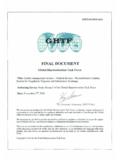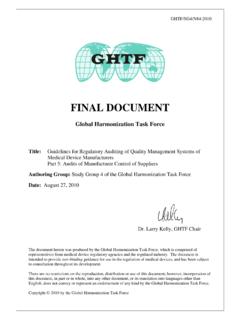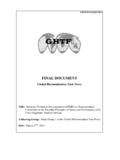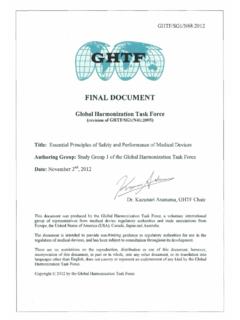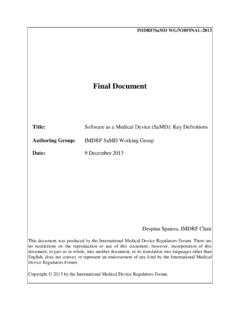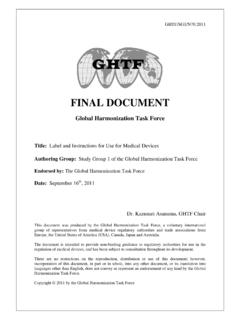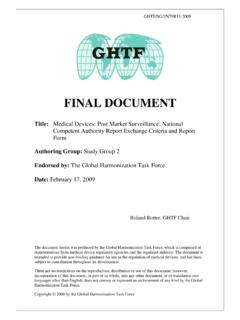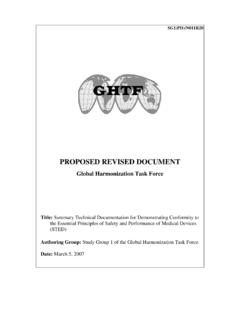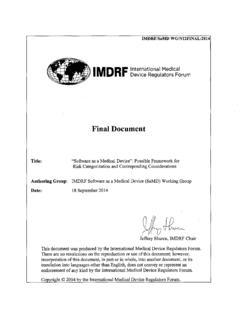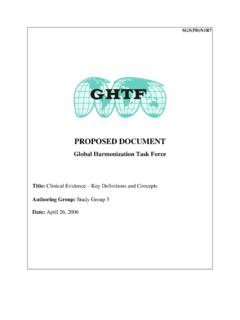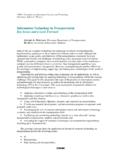Transcription of GHTF SG3 - Risk Management Principles and Activities ...
1 GHTF/SG3/N15R8 FINAL DOCUMENT Title: Implementation of risk Management Principles and Activities within a Quality Management system Authoring Group: GHTF Study Group 3 Endorsed by: The Global Harmonization Task Force Date: May 20, 2005 Abraao Carvalho, GHTF Chair This document was produced by the Global Harmonization Task Force, a voluntary international group of representatives from medical device regulatory authorities and trade associations from Europe, the United States of America (USA), Canada, Japan and Australia. The document is intended to provide non-binding guidance to regulatory authorities for use in the regulation of medical devices, and has been subject to consultation throughout its development.
2 There are no restrictions on the reproduction, distribution or use of this document; however, incorporation of this document, in part or in whole, into any other document, or its translation into languages other than English, does not convey or represent an endorsement of any kind by the Global Harmonization Task Force. Copyright 2000 by the Global Harmonization Task Force GHTF Study Group 3 SG3/N15R8 Page 2 of 23 Risk Management Guidance IMPLEMENTATION OF RISK Management Principles AND Activities WITHIN A QUALITY Management system 1. Introduction Purpose Scope 2. Definitions 3. General Documentation Communication 4. Management Responsibilities 5. Outsourcing 6. Planning 7. Design and Development Design and development planning Design and development input Design and development outputs Design and development review Design and development verification Design and development validation Control of design and development changes Design and development transfer 8.
3 Traceability 9. Purchasing Controls and Acceptance Activities Purchasing Controls Acceptance Activities 10. Production and Process Controls Manufacturing, Measuring and Monitoring Equipment Work Environment and Personnel Process Validation 11. Servicing 12. Analysis of Data 13. Corrective and Preventive Actions (CAPA) Annexes: Annex A An Example of a Risk Chart for Communicating Internal Risk Management Activities GHTF Study Group 3 SG3/N15R8 Page 3 of 23 Risk Management Guidance Annex B Flow Chart Risk Management Activities in Design and Development Annex C Example of A Risk Management Summary Table GHTF Study Group 3 SG3/N15R8 Page 4 of 23 Risk Management Guidance Implementation of risk Management Principles and Activities within a quality Management system 1.
4 Introduction: Medical device manufacturers are generally required to have a quality Management system as well as processes for addressing device related risks . These processes for managing risk can evolve into a stand-alone Management system . While manufacturers may choose to maintain these two Management systems separately, it may be advantageous to integrate them as it could reduce costs, eliminate redundancies, and lead to a more effective Management system . This document is intended to assist medical device manufacturers with the integration of a risk Management system or risk Management Principles and Activities into their existing quality Management system by providing practical explanations and examples. A basic understanding of quality Management system requirements and a basic knowledge of quality Management system terminology are assumed in this guidance document.
5 This document is based on general Principles of a quality Management system and general Principles of a risk Management system and not on any particular standard or regulatory requirement. This document also: Has general applicability to quality Management systems for manufacturers providing medical devices; Discusses risk Management related to medical device safety, rather than financial or other business risks ; Does not suggest a particular method of implementation; and Does not include requirements to be used as the basis of regulatory inspection or certification assessment Activities The scope of the medical device manufacturer s quality Management system will define the applicability and extent of implementing risk Management Principles and Activities .
6 Processes required by the quality Management system and performed by suppliers to the manufacturer are the responsibility of the manufacturer. Risk Management Activities relating to any process within the quality Management system are ultimately the responsibility of the manufacturer. An effective quality Management system is essential for ensuring the safety and performance of medical devices. A well-defined quality Management system includes safety considerations in specific areas. Given the importance of safety, it is useful to identify some key Activities that specifically address safety issues and ensure appropriate input and feedback from these Activities into the quality Management system . The degree to which safety considerations are addressed should be commensurate with the degree of the risk and the nature of the device.
7 Some devices present relatively low risk or have well-understood risks with established methods of risk control, while others push the state-of-the-art. GHTF Study Group 3 SG3/N15R8 Page 5 of 23 Risk Management Guidance Risk Management Principles should be applied throughout the life cycle of medical devices and used to identify and address safety issues. In general, risk Management can be characterized by phases of Activities . The following discussion is one example of how these phases can be described. The first phase can be the determination of levels of risk that would be acceptable in the device. Manufacturers should have a procedure or policy to determine risk acceptability criteria. These risk acceptability criteria may come from an analysis of the manufacturer s own experience with similar medical devices or research on what appears to be currently accepted risk levels by regulators, users, or patients, given the benefits derived from diagnosis or treatment with the device.
8 Risk acceptability criteria generally should be reflective of state-of-the-art in controlling risks . The second phase can be risk analysis. This phase starts with identifying hazards that may occur due to characteristics or properties of the device during normal use or foreseeable misuse. After hazards are identified, risks are estimated for each of the identified hazards, using available information. In the third phase, the estimated risks are compared to the risk acceptability criteria. This comparison will determine an appropriate level of risk reduction, if necessary. This is called risk evaluation. The combination of risk analysis and risk evaluation is called risk assessment. The fourth phase can be composed of risk control and monitoring Activities .
9 The manufacturer establishes actions, risk control measures, intended to eliminate or reduce each risk to meet the previously determined risk acceptability criteria. Within the limits of feasibility, one or more risk control measures may be incorporated in order to achieve this end. Risk control Activities may begin as early as design input and continue through the design and development process, manufacturing, distribution, installation, servicing and throughout the medical device life cycle. Some regulatory schemes prescribe a fixed hierarchy of risk control measures that should be examined in the following order: Inherent safety by design; Protective measures in the device or its manufacture; Information for safety, such as warnings, etc.
10 Throughout the life cycle of the device the manufacturer monitors whether the risks continue to remain acceptable and whether any new hazards or risks are discovered. Information typically obtained from the quality Management system , for example, production, complaints, customer feedback, should be used as part of this monitoring. If at any time, a risk is determined to be unacceptable, the existing risk analysis should be reexamined and appropriate action taken to meet the risk acceptability criteria. If a new hazard is identified, four phases of risk Management should be performed. These Activities can be performed within the framework of the quality Management system . Purpose This guidance document is intended for educating the medical device sector.
